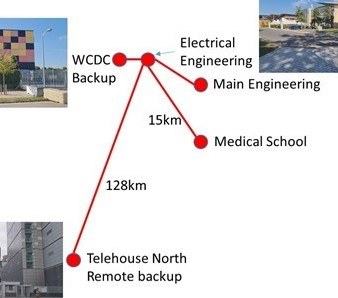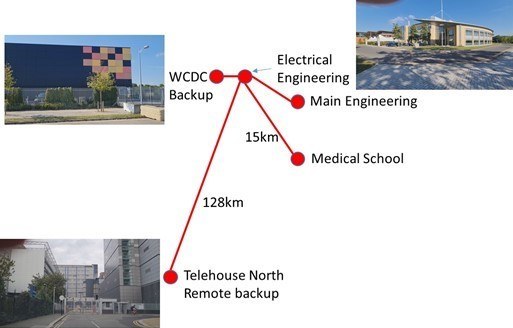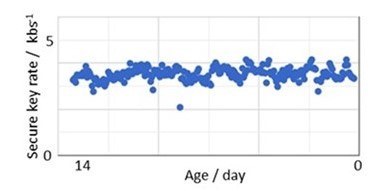
Case study: Long-distance Quantum Key Distribution secured multi-homed data backup
NDFF demonstrate a network that uses Quantum Key Distribution (QKD) to enable secure encrypted data transmission on a multi-site network.
The advent of Quantum Computers is predicted to render current encryption techniques insecure and that data in transit today can be stored and decrypted in the future. To overcome this problem, we demonstrate a network that uses Quantum Key Distribution (QKD) to provide secret keys to enable secure encrypted transmission of data between storage nodes on a multi-site data backup network.

Fig 1: Cambridge multi-homed QKD secured back-up network locations
A vital component of this network is a data backup site which is distant from the main data storage facility and thus the ability to use the NDFF to enable the siting of nodes in Cambridge and London is crucial. A significant issue is the 128 km distance and thus large 28dB optical loss of the fibre path of this link.
This is a major challenge for QKD since a high loss will reduce to the key rate or even cause the quantum link to fail. This challenge is met by the use of state of the art QKD systems procured from Toshiba, which can overcome the 28dB loss of the 128km fibre span. We can report state of the art performance of QKD over this link with a secure key rate of 3.4 ± 0.2 kb/s over a 28 day period.

Fig 2: Stable QKD secure key delivery over 128km single span NDFF fibre link between Cambridge and London
This work has been funded by the UK EPSRC Quantum Communications Hub EP/T001011/1.
For further information, contact Adrian Wonfor, ndff@ee.ucl.ac.uk.
Published: 18 March 2022
